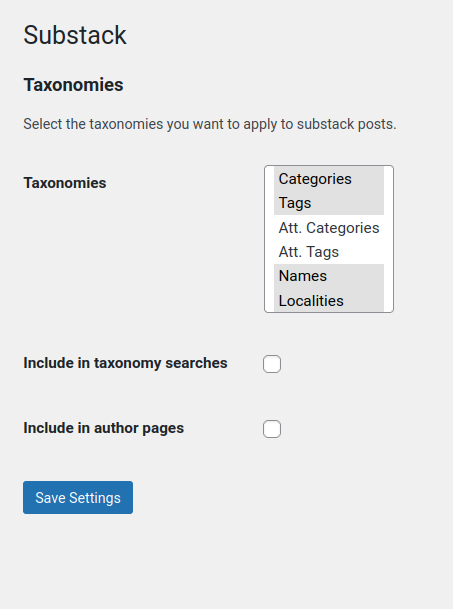Write and keep your Substack posts in your WordPress blog.
Description
This plugin allows you to write and keep archives of your Substack posts in your own WordPress site.
There are some advantages to this approach:
- You have a copy of your content on your site, no matter what might happen to Substack in the future;
- You can integrate your Substack content into your WordPress site, where it can appear in searches, archive listings and in generated lists, for example with the Query Loop block. It becomes trivial to have “Latest Substacks” page or section on a front page;
- Each Substack post can easily be made to redirect to the published newsletter on Substack.com, so search engines don’t see duplicate content. Twitter notoriously won’t do link previews of Substack links, so the plugin doesn’t redirect Twitter, only the user.
The main disadvantages are a duplication of effort, and an extra step in publishing on Substack.
Example workflow
This is an example of how the plugin can be used.
- Write your Substacks in the WordPress interface, using the writing tools you’re used to;
- Upload the pictures you need and include them in the text;
- Add categories, tags, excerpt and featured image, for use on your WordPress site;
- Once you’re satisfied, open the preview and copy the text to the clipboard;
- Open Substack.com, and paste the title, excerpt and text into their editing interface;
- Publish on Substack.com and send your post to your subscribers;
- Copy the link to the Substack post to the clipboard;
- On your WordPress site, insert an HTML block at the top of the Substack post, and add a HTML comment containing just the URL of the post on Substack;
- Publish on WordPress.
If you schedule posts on Substack, schedule them a few minutes later on your WordPress site.
You can edit posts on Substack.com later, but as the system is email based, your original post is already in the inbox of your subscribers, and that message won’t be changed.
Settings
The settings page only has a few options.
- Which of the taxonomies on the site do you want to apply to the Substack post type (multiple sections are possible);
- Whether to include Substacks in taxonomy searches;
- Whether to include Substacks on author pages, if enabled.
Implementation details
The Substack plugin creates a new ‘substack’ post type, with all the characteristics of normal posts. It will appear in the WordPress admin interface in the left column with the Substack logo.
You can work with these posts within WordPress just as with normal posts.
Any request for a Substack post on the public site will result in a redirect to the post on Substack.com, if the HTML comment is inserted. Otherwise the post is simply displayed normally.
The queries used for taxonomy searches and author pages are intercepted, and the ‘substack’ post type is included in the search if selected in the settings.
Changelog
1.0
- First published version.
Screenshots


Leave a Reply